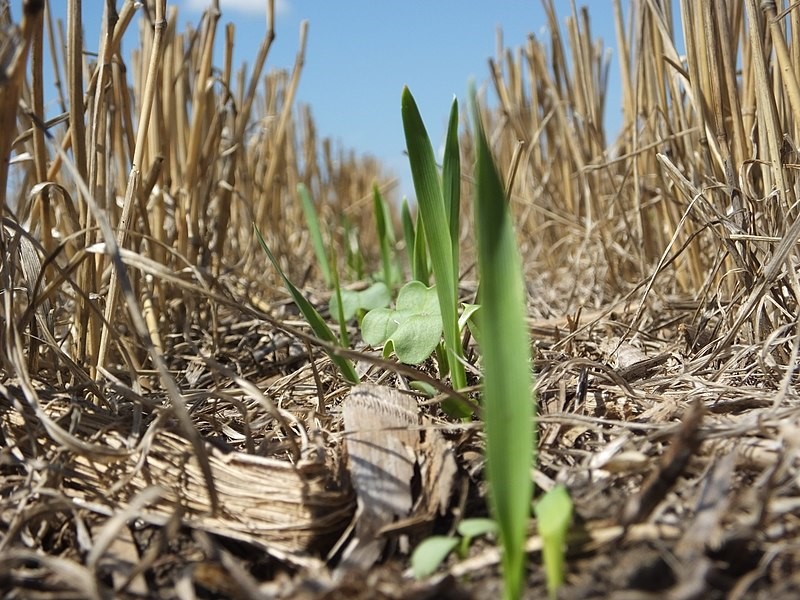Pressures to feed an ever-growing global population have led to the widespread adoption of “industrial agriculture,” the large-scale, intensive production of crops and animals, often relying on soil tilling and frequent applications of chemical fertilizers. In addition to the many environmental impacts of such high-intensity activities, industrial agricultural practices also release greenhouse gases (GHGs) like CO2 and N2O to the atmosphere. The global food production system accounts for more than 15% of all human-related GHGs.
Sustainable farming practices that minimize impacts on soil systems and surrounding ecosystems have long been employed at smaller scales. But regenerative agricultural practices are being proposed as a means of food production that can also improve the environment. In particular, scientists, farmers, and others in the agricultural community have begun to explore how soils can contribute to climate mitigation by sequestering large quantities of CO2, the opposite of conventional agriculture. With agricultural uses covering more than a third of the Earth’s land surface, it is estimated that by employing regenerative agricultural practices, soil carbon sequestration could remove up to 20 gigatons of CO2 over the next several decades.
To bring regenerative agricultural practices into greater use, region-specific practices must be investigated and adopted, with technical and financial support to help farming communities make the transition. In this unit, you’ll investigate several regenerative agriculture techniques that can reduce the loss of carbon from soils.

The Problem
Modern agriculture is beset by a host of environmental problems, ranging from human health threats from exposure to pesticides and herbicides to pollution caused by the runoff of sediments into nearby waterways.
These practices also impact the soil system itself, with more than 20% of the world’s soils experiencing various degrees of degradation.
The USDA estimates that agriculture accounted for 11.2 % of U.S. GHG emissions in 2020, primarily from cropped and grazed soils.
Globally, soils store three times more carbon than is present in the atmosphere and four times the amount in living plants and animals, making it a significant carbon sink.
Because nearly half of the globe’s arable land now supports pastures, rangelands, and croplands, soils have lost 50 to 70% of the carbon they once stored (Cho, 2018).
Proper soil management can regenerate a soil’s ability to sequester and store carbon.
The Role of Climate Change
Agricultural practices can create soils that act as either a significant source of GHG emissions or a significant carbon sink.
Fossil fuel inputs are needed by industrial agriculture to plant, fertilize, and process raw materials into consumer-ready products and distribute the finished products around the globe.
Cattle and other livestock emit the potent GHG methane (CH4)from their digestive tracts, and food waste releases CH4 as it decomposes.
But climate impacts agriculture as well.
Warmer temperatures also increase microbial activity, which speeds decomposition and the release of SOC pools.
Solutions
But regenerative agriculture focuses on the interconnections of farming systems and the ecological system as a whole, with the goal of rebuilding soil organic matter (SOM) (thus sequestering carbon) and restoring degraded soil biodiversity (improving soil and ecosystem function) (Newton et al. 2020).
While exact techniques vary, regenerative agriculture’s underlying principles include:
The Scenario
Carbon-capturing soil amendments include sugarcane bagasse and biochar, a charcoal-like substance that’s made by burning organic material from agricultural and forestry wastes in a controlled process called pyrolysis.
To manage weeds around the planted crops, a variety of methods can be used, including free–range livestock and tractor implements such as the roller crimper, which farmers can use to lay down a weed-suppressing mat that can be planted through in one pass.
Build Your Foundational Knowledge
Biochar amendments:
Soil amendments and inoculants, Biochar basics
No-till farming:
What is no–till farming?, Advantages and disadvantages of no–till farming
Pros and cons of organic vs. chemical fertilizers
Small Group Guided Worksheets
Additional sources:
Biochar amendments: Biochar for climate change: Is it a viable strategy? | Farming Connect (gov.wales)
No-till farming: Could No–Till Farming Reverse Climate Change? (usnews.com)
Organic fertilizers: Organic Agriculture Helps Solve Climate Change | NRDC